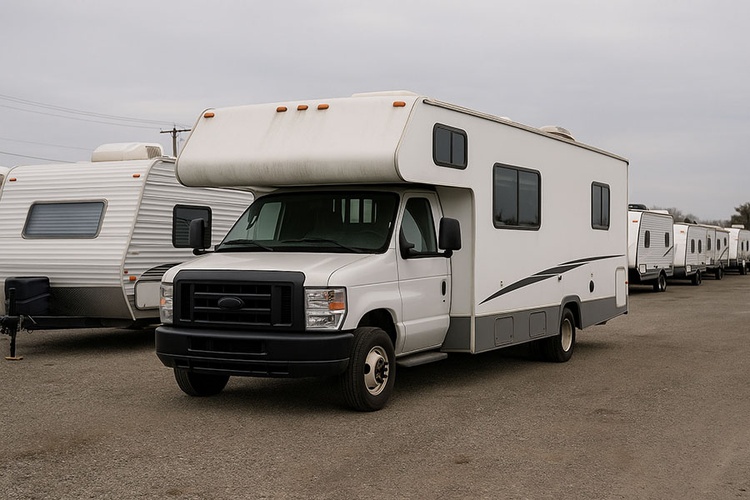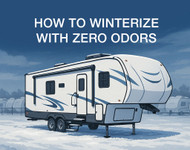How to Store RV Tanks Odor-Free for Winter (Expert Guide)
Posted by Happy Campers Store on Oct 29th 2025
How to Store Your RV With Clean Tanks and Zero Odors (and When to Do a Total Tank Reset)
Published October 2025 • Happy Campers Store

Why Tank Odors Return After Storage
Even after a complete dump, invisible films of waste, grease, and soap residue remain on the interior surfaces of your RV’s holding tanks. During storage, these residues dry out, trap odor compounds, and can re-activate when moisture returns in spring. Understanding this chemistry is key to maintaining a truly odor-free system.
If your rig smells like sewage after sitting, it’s not “new waste”—it’s old residue that rehydrates and releases gases once you start using the plumbing again. Learn more about this process in Why Your RV Smells Like Sewage (And How to Fix It).
Before You Begin: Pre-Storage Inspection Checklist
Perform these checks before you start your final clean-out:
- Check tank levels and sensors: Make sure sensors are reading accurately; false readings often signal buildup.
- Inspect seals and valves: Look for cracks or leaks, especially around gate valves and pipe fittings.
- Verify vent system integrity: Clogged or damaged roof vents can trap gases and worsen odor during storage.
- Clean around toilet base and flanges: Residue at these junctions often causes hidden smells.
Step 1: Empty and Flush Both Tanks Thoroughly
Start with a complete dump at an approved station. Use a clear sewer elbow to observe the flow. Continue flushing until water runs clear from both tanks. If you see paper fragments or dark streaks, keep rinsing—these indicate organic buildup that can harden during storage.
For best results, complete a deep clean using proven steps from How to Deep Clean Your RV Black Tank. A true flush removes sludge and prepares the surface for the final odor-neutralizing rinse.
Step 2: Rinse With Treatment, Then Drain Completely
After flushing, fill each tank with a few gallons of clean water and add your preferred RV holding tank treatment. Drive or agitate gently to let the solution contact all surfaces. This neutralizes remaining odor molecules and leaves a fresh base layer on the interior walls. Drain completely afterward so no waste water remains.
See comparison data for mineral, enzyme, and chemical formulas in Best RV Holding Tank Treatments Compared (2025 Guide & Reviews).
Step 3: Choose Your Storage Method — Dry or Treated
RVers use two reliable methods for odor-free tank storage. The right choice depends on temperature, humidity, and how long your RV will sit.
Option A: Dry Storage (Best for Freezing Climates)
Drain tanks completely and close all valves. Any remaining moisture can expand if frozen, risking cracks in fittings. Once drained, your tanks are safe and stable. Contrary to old myths, an empty tank won’t develop odor because odor compounds require moisture to activate.
Option B: Treated Storage (Ideal for Mild Climates)
If your RV will sit in moderate temperatures, leave two to four gallons of clean water mixed with an RV-safe odor control treatment in each tank. This keeps gate seals hydrated, prevents valve dry-rot, and maintains a deodorized environment through winter. Many long-term RVers prefer this method for covered storage or coastal climates.
Important: Always start with clean tanks. Add treatment to fresh water only—never to leftover waste or antifreeze.

Step 4: Don’t Forget the Gray Tank
Your gray tank collects soapy water and grease—both can create sticky films that smell worse than sewage when stored. After draining, fill with a few gallons of warm water and a mild treatment. Let it sit overnight, then flush completely. For an in-depth look at what builds up inside, read Cleaning Your RV Gray Tank to Prevent Odors and Clogs.
Step 5: Protect Valves, Seals, and Gaskets
After cleaning, inspect your gate valves. Apply a thin layer of food-grade or silicone lubricant to prevent drying. Wipe residual water from around the handle rods and ensure the cap seals tightly. A dry, protected valve system is critical to preventing spring leaks and early wear.
Step 6: Winterize the Plumbing System
Drain or blow out freshwater lines and pump a safe amount of RV antifreeze through the plumbing. This step is separate from your holding tanks but equally important for preventing freeze damage. For complete winterizing guidance, see How to Winterize an RV for Storage or Living.
Spring Kick-Off: The Right Time for a Total Tank Reset
When spring returns, even well-maintained tanks develop thin, dried films on interior walls. These layers are now brittle—perfect for removal. Performing a Total Tank Deep Clean Reset at this stage dissolves residual buildup before you begin adding regular treatments again.
How to Perform a Tank Reset
- Start with empty tanks and closed valves.
- Fill each tank halfway with warm water.
- Add a full-strength tank cleaner per manufacturer’s instructions.
- Let sit for 12–24 hours (stationary) or drive to agitate the solution.
- Drain and flush thoroughly with fresh water until clear.
This one-time spring process removes biofilms, mineral deposits, and odor residue while restoring sensor accuracy.
Troubleshooting Common Post-Winter Issues
- Persistent odors: Run a tank rinse with treatment; if odor returns quickly, complete a full reset.
- Stuck valves: Flush warm water through the outlet; never force handles. Lubricate after freeing.
- False sensor readings: Usually film-related; follow a reset and recalibrate sensors.
- Slow drain flow: Check for buildup at the pipe bends or hose slope; review Deep Cleaning Guide for clearing partial blockages.
Summary: Clean Storage = Fresh Start
Storing your RV tanks correctly is simple chemistry and good maintenance combined. Remove waste films, protect seals, and choose the right moisture strategy for your climate. Then, perform a complete tank reset before your first trip to eliminate any residue that dried over winter.
Ready for an Odor-Free Season?
Follow these steps to keep your RV tanks—and your travels—fresh all year long. Clean before storage, protect through winter, and reset in spring. Your sensors will stay accurate, your valves smooth, and your RV will smell like adventure, not a sewer.
© 2025 Happy Campers Store. Educational guide for RV owners and full-timers who want reliable, science-based tank care.


